Music in the Daily Life of Vermeer: The Midwinterhoorn
by Adelheid Rech
by Adelheid Rech
The horn is one of the oldest known musical instruments of mankind. First made of animal horn (ram, goat, bull, ox) it had been employed by the "primitive" peoples of the pre-historic times both for signaling and performing ancient rites. In later times, midwinterhoorn is made a wooden tube made from a branch that follows a natural curve, often from a willow or elder tree. The mouthpiece, or "happe," is traditionally made from elder wood.Elder wood, derived from the elder tree of the genus Sambucus, is known for being soft, lightweight, and having a pithy center. This makes it easy to hollow out, suiting it particularly for crafting wind instruments like the mouthpieces of midwinterhoorns. Elder wood's softness means it's not typically used for heavy construction or durable woodworking. Apart from musical instruments, it's also used for various crafts and tools like whistles and pipes. Additionally, the elder tree has historical significance in folk medicine and mythology, with different parts used for medicinal purposes. However, caution is advised as some parts of the elder tree, like leaves, stems, and raw berries, can be toxic if not properly prepared. Elder trees are sometimes also used in gardening and landscaping for their ornamental value. Making a midwinterhoorn is considered an art form and requires significant skill. The process involves hollowing out the wood and shaping the instrument, which is usually done by hand following traditional methods.
The blowing the shofar, the principal horn of the Jews, is frequently mentioned in the Bible (Ancient Testament) and the Talmud. It served to announce special days like New Year's Day, New Moon etc. and together with the trumpet it was used to signal the start of a war. Wooden horns were already known from ancient Mesopotamia in the time c. 2700 B.C.
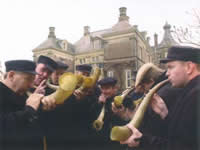 Ossenhoorn-players in Markelo (Overijssel).
Ossenhoorn-players in Markelo (Overijssel).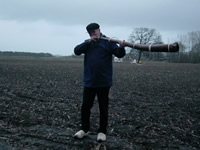 A today's farmer is blowing the midwinterhoorn on his field.
A today's farmer is blowing the midwinterhoorn on his field. Click here for period horn music: A signal played on two "Revheim"-lurs, found in 1894 by people from the Revheim-farm in a large bog, called Revheimsmyra, close to the Hafrsfjord in Rogaland, Norway. The instruments are still in good condition, so that it is possible to play on them.
Performed in 1958 by two hornplayers.
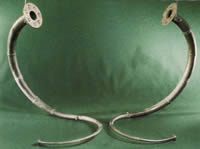
The two "Revheim"-lurs from the Revheimsmyra, Rogaland, Norway. Today they are housed in the Museum of Archaeology, Stavanger, Norway.
For the ancient peoples living in the northern most part of the hemisphere, the winter was most difficult time of the year. Its gelid winters with seemingly endless darkness shrouded deep anxieties, the dread of evil spirits and the deepest dread of all: that the sun might never return. In response, the population devised rites and mystical practices to alleviate the uncertainties of the natural world. In the Germanic pagan Joelfeest or Yule, celebrated for twelve days around the winter solstice (c. December 21), the Batavians blew on cow horns to spur the god Odin (or Wodan) in his "Wild Hunt" to fight against the huge wolf Fenrir who chases the sun in a large chariot. The horn helped to frighten the wolf away so that the sun could once again return. The inhabitants of the Twente-area, in particular, blew the ossenhoorn ("ox horn"), a forerunner of the midwinterhoorn.
People in the early times also believed that on Midwinter"Midwinter" corresponds with the winter solstice in the Northern Hemisphere, typically occurring around December 21st or 22nd, and is characterized by the year's shortest day and longest night. Historically significant across various cultures, midwinter has been celebrated through numerous festivals and rituals, reflecting its importance in marking the astronomical start of winter and its cultural and spiritual symbolism. night their ancestors arose from "Mother Earth." However, Midwinter was also a symbol of procreation. Being the darkest day of the year, the following days gradually became longer bearing hope for the return of the light. As days grew longer, new live began to flourish once again. Thus, peasants played the midwinterhoorn in their fields in order to dispel evil spirits and please the gods of fertility who let their fruits grow in the lap of "Mother Earth."
Both the construction of the midwinterhoorn and time in which it was played relates to ancient myths and fertility rites. The wood from which it is made relates to the "fruit" of "Mother Earth") as well as water, the other source of all live.
Once the two sections of the "wet horn" (see below) were put together, the instrument was submerged into a well so that the bulrush inserted between the two halves would swell up and make it airtight.
Curiously, the midwinterhoorn, and especially the "wet horn," is often blown over a well, which enhances the sound of the horn and demonstrates the natural relationship between water and wood. When the horn freezes in winter, it produces a particularly brilliant sound that encouraged peasants to awake the spirits of fertility so that they might produce more abundant harvests. Moreover, one has to consider that the Twente-area is in great part composed of marshy soil and venen (bogs). Consequentially water and soil had a particularly deep impact on survival.
Midwinter was also the time for bidding farewell to the "dying" old year and awaiting its rebirth into the new year—a true "holy time." It is not by chance that the Early Church determined the December 25 (shortly after Midwinter) as Christmas Day, the feast of the birth of Jesus Christ as the redeemer of all mankind, who will bring a new, eternal light into the dark world. The aim of the Church was partly to induce the Romans and other pagans to convert to Christianity without forsaking their own winter celebrations when their gods and goddesses had their "birthdays" on the exact same day, in particular the god "Sol Invictus" ("the Unconquered Sun").
During Midwinter people spent most of the time in their homes. It was a period which has always been full of rites, celebrations and festivities, whether pagan or Christian. Christmas celebrations took place from c. mid-fourth century onwards. Since Northern Europe was the last part to Christianize, its pagan celebrations had a major influence on the celebration of Christmas, already evident in the number twelve (the period of the Germanic Yule relates to the Twelve Holy Days after Christmas Day). This period had always been the principal time for the playing of the midwinterhoorn, or, in early times, its forerunner, the ossenhoorn.
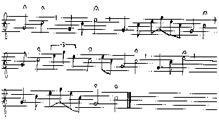 The "oalde roap" from Ootmarsum
The "oalde roap" from Ootmarsum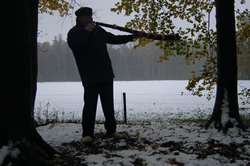 A farmer playing the midwinterhoorn in the misty twilight of a winter's day at the edge of a snowy field.
A farmer playing the midwinterhoorn in the misty twilight of a winter's day at the edge of a snowy field.Eve though the midwinterhoorn is mainly blown in the four weeks of Advent to announce the coming of Jesus Christ, Christmas Day and New Year's Day to welcome the new year, its playing still may possess secret pagan meaning which mingled with Christian customs.
Last but not least, the midwinterhoorn was used to signal danger, whether from fire, water or enemies. During the Eighty Years' War was a constant threat in the area of Twente since it was a Catholic enclave in a Protestant country. Its sound warned those attending the Holy Mass of Protestant incursions.
It was particularly useful for the people who inhabited the marshy lands to call for help as the next farm was often some kilometers away. The loneliness of those dark times was not always easy to bear and so peasants blew their horn at regular intervals to "ask" if the neighbor is still alive or hear if there is someone else in the vicinity.
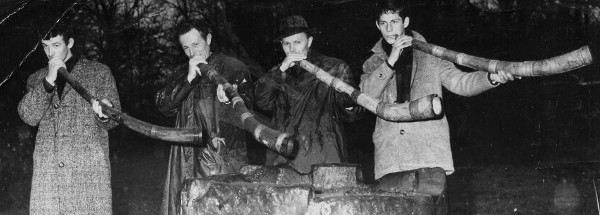 A quartet of midwinterhoorn players from the village Saasveld during a senior contest. However, it has to be considered that the midwinterhoorn is by all means a solo-instrument as each one is singular in its shape and sound, so that a real harmonic tuning between the instruments is impossible.
A quartet of midwinterhoorn players from the village Saasveld during a senior contest. However, it has to be considered that the midwinterhoorn is by all means a solo-instrument as each one is singular in its shape and sound, so that a real harmonic tuning between the instruments is impossible.With the improved drainage and the modern means of communication in the middle of the eighteenth century the use this type of signaling gradually died out, though players still blew to each other as a kind of playful question-and-answering. The midwinterhoorn as a signaling device was revived during World War II in Holland when local farmers used it to warn of approaching military patrols coming from the nearby German border.
In the 1950s, local enthusiasts in the area of Twente began to revive the traditional custom of playing the midwinterhoorn from the first Sunday in Advent until Epiphany and contests between the villages decree the best player. But as tradition dictates, no midwinterhoorn-player would ever play his instrument before or after these exact dates, not even for practicing.
Click here to view a short video of midwinterhoorn music:
Gerwin Winkelhuis is playing a large midwinterhoorn, placing it on a well.
Click here to view a short video of midwinterhoorn music:
A member of the midwinterhoorn-group D'Olde Roop from Zelhem (province Gelderland) plays some chords from the Oalde Roap.
If you discover a  or anything else that isn't working as it should be, I'd love to hear it! Please write me at: jonathanjanson@essentialvermeer.com
or anything else that isn't working as it should be, I'd love to hear it! Please write me at: jonathanjanson@essentialvermeer.com